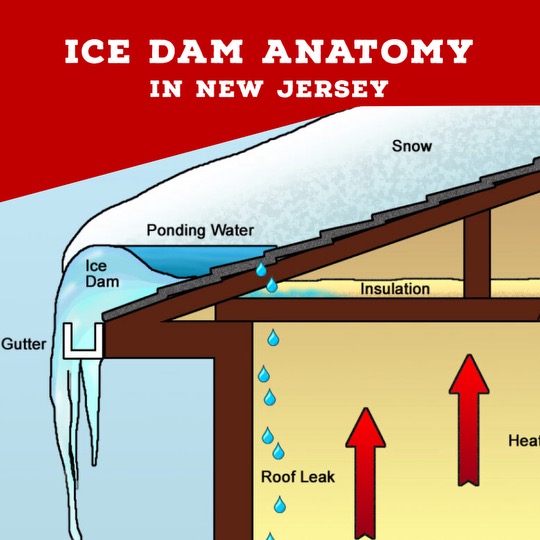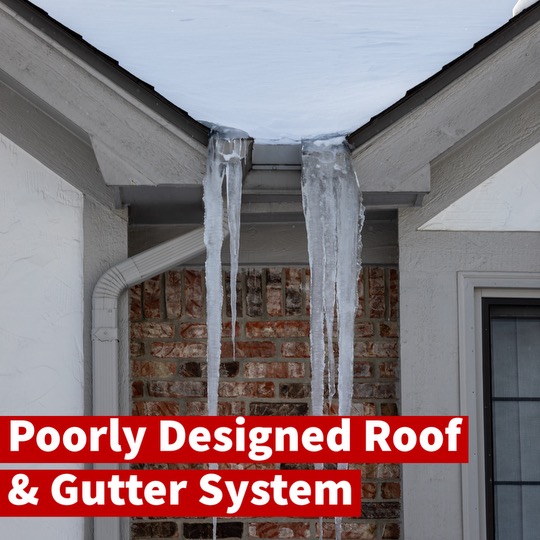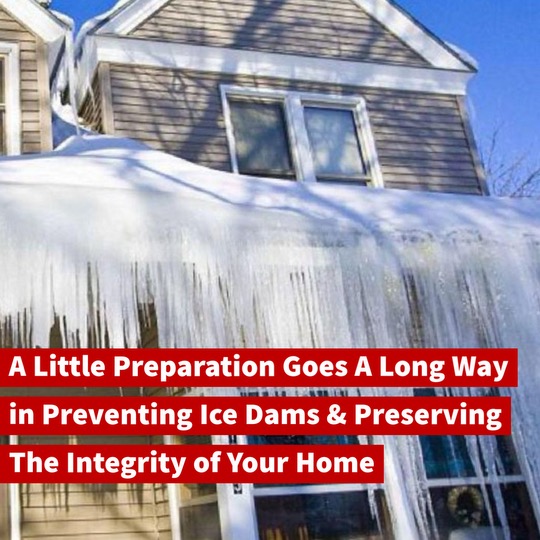With over half a century of experience under our tool belt, we have seen firsthand the havoc that ice dams can wreak on New Jersey homes. For homeowners, the winter brings not just the promise of picturesque landscapes but also the potential for serious what is too often thought to be only a roofing issue, the most notorious of which is ice damming along the eaves. Our decades in the roofing business have provided us with a deep understanding of the causes, consequences, and most importantly, the prevention of these icy intruders.
The Anatomy of an Ice Dam

Ice dams are more than just icicles hanging off the gutter; they are symptomatic of a larger problem. These ice formations occur at the roof’s edge, blocking the path for melting snow to drain off. This happens when heat escapes from your home and warms the upper sections of the roof, causing snow to melt despite freezing temperatures. The melted snow then trickles down to the colder eaves, where it refreezes and forms a dam, trapping subsequent meltwater and leading to potential leaks and damage.
Through years of battling ice dams, we honed a comprehensive approach to prevention that I share with my clients:
Beef Up Insulation:
Attic insulation is your first line of defense against heat loss. Ensuring you have a properly insulated attic that meets New Jersey’s recommended R-values is crucial. In central and northern New Jersey this seems to be the all time #1 issue homeowners don’t know they have.
Enhance Ventilation:
A well-ventilated attic is key to maintaining a uniform roof temperature. Adequate ridge and soffit vents allow cold air to enter and warm air to escape, preventing the heat buildup that causes snow to melt unevenly. Majority of roofs that are replaced are not properly ventilated. The most common ventilation must haves ignored by roofing contractors and homeowners alike are:
- Only installing exhaust venting (such as a ridge vent with no air intake)
- Mixing types of exhaust venting – such as a ridge vent system combined with a roof fan system (these will surely short circuit any efforts towards proper ventilation).
- Lack of or no intake venting along eaves. .
Seal the Leaks:
Over the years, I’ve seen how air leaks can undermine a roof’s integrity. Sealing around light fixtures, pipes, and chimneys can prevent warm air from seeping into the attic and contributing to ice dam formation. For example, Heat loss from something simple like recessed lights can cause condensation and or ice damming.
Simplify Your Roof:
Complex roof designs with lots of valleys and nooks are picturesque, but they also create many spots for snow and ice to accumulate. When designing or modifying a roof, aim for simplicity to minimize these problem areas. To create a roof replacement plan on existing complex structures be sure to connect with a true professional in the roofing industry.
Clear Gutters and Downspouts:
Keeping gutters clean is a year-round job. Before the snow flies, ensure your gutters and downspouts are free from debris to encourage proper drainage.
Consider Materials and Build:
In my experience, materials like metal roofing or rubberized underlayments beneath shingles can prevent water from seeping into your home, even if an ice dam forms.
Regular Roof Raking:
After a heavy snowfall, it’s often necessary to remove snow from the roof. This is where a roof rake comes in handy, allowing you to clear snow from the safety of the ground. These tools can be purchased at home improvement stores through out NJ. Professional roofing companies will also offer this as a service if needed.
Call in the Professionals:
Certain situations call for a professional touch. If you’re not equipped to deal with an ice dam or if the problem persists, don’t hesitate to call in a seasoned roofing contractor.
The Painful Price of Neglect
Ignoring the signs of ice dams can lead to a litany of problems: damaged shingles, ruined insulation, warped floors, peeling paint, and even collapsed ceilings. In our years on the job, I’ve seen too many homes suffer from the owner’s inaction. The cost of prevention is always less than the price of repairs.

Continuing a Legacy of Vigilance
The key to preventing ice dams lies in routine maintenance and a proactive approach to home care. Snow and ice might be a part of life here in New Jersey, but with the right knowledge and action, their impact on your home doesn’t have to be.
Energy Audits:
A professional energy audit can pinpoint exactly where your home is losing heat. With infrared cameras and blower door tests, auditors can find the leaks that I’ve seen cause so many problems over the years. Addressing these leaks is a smart investment that pays dividends in both ice dam prevention and energy savings.
Heat Cables:
For immediate relief, heat cables can be a temporary solution. Installing them in a zigzag pattern along the roof’s edge provides channels for meltwater to escape. While not a fix-all, they can help manage an immediate ice damming issue until more permanent solutions are put in place.
Snow Retention Systems:
For metal roofs, which are becoming increasingly popular due to their durability and ice dam resistance, snow retention systems can be installed to prevent dangerous sheets of ice and snow from sliding off and damaging property—or even causing injury.
Professional Snow Removal:
When the snow gets too thick, it’s time to call in professionals who can safely remove it from your roof. They have the experience and equipment to do the job without damaging your shingles, something that can happen all too easily when homeowners attempt this task themselves.
After five decades in the roofing industry, we have come to see ice dams as more than just a seasonal nuisance—they’re a sign that a home isn’t performing as efficiently as it should. They’re a call to action for homeowners to fortify their defenses against the cold.
The Bottom Line
The true cost of an ice dam isn’t just measured in the immediate damage it can cause, but also in the increased heating bills and the premature aging of your roofing system. With the right measures, you can protect your home, save money, and enjoy peace of mind.
Remember, the best offense is a good defense. In our many years as a roofing contractor, I’ve seen the wisdom of this adage proven time and again. So, as the New Jersey winter looms, take it from someone who’s spent a lifetime on the roofs of this state: a little preparation goes a long way in preventing ice dams and preserving the integrity of your home.
